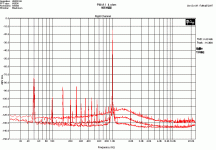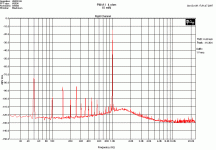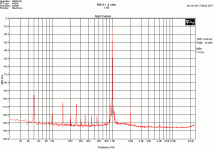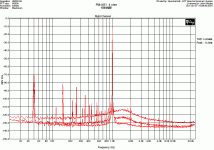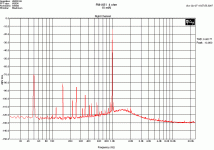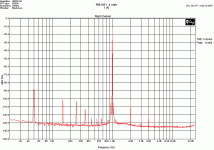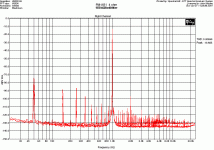Bob Cordell said:
What PC software do you use with your Juli@ card for spectral analysis?
Thanks,
Bob
http://www.diyaudio.com/forums/showthread.php?s=&postid=1312164&highlight=#post1312164
I have noticed Audacity gives occasional dropouts: I've seen ~100mS gaps with 24/192K on a refurb gateway 2.0 GHz XP home 1 G dram, proabably need to check with 2nd channel digitizing the drive V to see if smaller dropouts aren't ruining the data, maybe slower would work better, need to find settings to optimize cpu performance, maybe ram disk?
the Juli@ does suffer from noise spurs, it looked like the emu 1820m was somewhat better @ ~ US$500, other cards/usb boxes in the prosumer world should be pretty good
mige0,
theoretical noise floor is:
SNR = 6.02N + 1.76dB + 10 log(M/2)
N ..... number of bits of A/D
M .... number of samples in FFT record
For this reason, it is possible to get something like 125-130dB even from 16-bit A/D.
My "noise floor" image was taken with 24-bit, 128K samples.
1Vrms (0dB) is close to max. level, so the narrowband SNR is up to some 140dB in the midband. The higher M (more samples in FFT), the narrower band of noise analysis.
theoretical noise floor is:
SNR = 6.02N + 1.76dB + 10 log(M/2)
N ..... number of bits of A/D
M .... number of samples in FFT record
For this reason, it is possible to get something like 125-130dB even from 16-bit A/D.
My "noise floor" image was taken with 24-bit, 128K samples.
1Vrms (0dB) is close to max. level, so the narrowband SNR is up to some 140dB in the midband. The higher M (more samples in FFT), the narrower band of noise analysis.
Hi
Yeah, with resolution cranked up to 0,17 Hz ( 262144 FFT points implemented in AudioTester due to a feature request of mine some time ago ) it looks really impressive !
Noise floor is down a 150 dB from full scale this way.
Same setup as shown in earlier posts ( done at 4096 FFT points ) but scaled to full scale and average = 5.
The lower noise floor with signal applied is most likely due to the low source impedance of the –60 dB divider of around 50 Ohm compared to the no signal input impedance of around 10 kOhm.
Wonder if that can be topped by earls method ?
Greetings
Michael
PMA said:mige0,
theoretical noise floor is:
SNR = 6.02N + 1.76dB + 10 log(M/2)
N ..... number of bits of A/D
M .... number of samples in FFT record
For this reason, it is possible to get something like 125-130dB even from 16-bit A/D.
My "noise floor" image was taken with 24-bit, 128K samples.
1Vrms (0dB) is close to max. level, so the narrowband SNR is up to some 140dB in the midband. The higher M (more samples in FFT), the narrower band of noise analysis.
Yeah, with resolution cranked up to 0,17 Hz ( 262144 FFT points implemented in AudioTester due to a feature request of mine some time ago ) it looks really impressive !
Noise floor is down a 150 dB from full scale this way.
An externally hosted image should be here but it was not working when we last tested it.
An externally hosted image should be here but it was not working when we last tested it.
Same setup as shown in earlier posts ( done at 4096 FFT points ) but scaled to full scale and average = 5.
The lower noise floor with signal applied is most likely due to the low source impedance of the –60 dB divider of around 50 Ohm compared to the no signal input impedance of around 10 kOhm.
Wonder if that can be topped by earls method ?
Greetings
Michael
scott wurcer said:Yes this should work. I forgot that I published some results in an AES preprint (don't remember the number) using a filtered Soundtech generator. [snip]
Scott,
I have been unable to find an AES preprint (searched on author name) on this. Any change you can remember the title or number?
Thanks,
Jan Didden
Hi
PMA, when calculating your formula for 24 bit and 4k samples and 128k samples respectively the result is somewhere around 160 dB SNR, differing roughly 1 dB only .
Seems to be wrong, no ?
Greetings
Michael
PMA said:mige0,
theoretical noise floor is:
SNR = 6.02N + 1.76dB + 10 log(M/2)
N ..... number of bits of A/D
M .... number of samples in FFT record
For this reason, it is possible to get something like 125-130dB even from 16-bit A/D.
My "noise floor" image was taken with 24-bit, 128K samples.
1Vrms (0dB) is close to max. level, so the narrowband SNR is up to some 140dB in the midband. The higher M (more samples in FFT), the narrower band of noise analysis.
PMA, when calculating your formula for 24 bit and 4k samples and 128k samples respectively the result is somewhere around 160 dB SNR, differing roughly 1 dB only .
Seems to be wrong, no ?
Greetings
Michael
As promised, I made measurements at low power. Load was 4ohm, power 10mW, 100mW and 1W. I equalized measurements at same peak level, corresponding to lowest power, by means of a voltage divider. Peak level is always declared in plots.
For low powers, there seems to be generator contribution in noise floor modulation. Amplifier itself, wit input shorted, does not show such increase and modulation of noise floor, measured at same sensitivity.
The 1st plot is complete view at all the 3 measurements:
For low powers, there seems to be generator contribution in noise floor modulation. Amplifier itself, wit input shorted, does not show such increase and modulation of noise floor, measured at same sensitivity.
The 1st plot is complete view at all the 3 measurements:
Attachments
Very interesting.
Well, i should be easy to distinguish generator effects from generator+amp effects, by measuring
- generator by itself into some input impedance similar to the amp's
- generator into the amp, signal off
Because it could also be the amp's reaction to generator input.
PMA said:
For low powers, there seems to be generator contribution in noise floor modulation. Amplifier itself, wit input shorted, does not show such increase and modulation of noise floor, measured at same sensitivity.
Well, i should be easy to distinguish generator effects from generator+amp effects, by measuring
- generator by itself into some input impedance similar to the amp's
- generator into the amp, signal off
Because it could also be the amp's reaction to generator input.
MBK said:Very interesting.
Well, i should be easy to distinguish generator effects from generator+amp effects, by measuring
- generator by itself into some input impedance similar to the amp's
- generator into the amp, signal off
Because it could also be the amp's reaction to generator input.
Generator itself was measured, but it is not the case. The amp has 27dB voltage gain and amplifies generator noise floor. This is not seen when measuring generator itself. The solution would be voltage divider at generator output.
But why is there noise floor modulation in the case generator+amp, but not in the case generator alone? The amp should amplify all noise equally no?
MBK said:But why is there noise floor modulation in the case generator+amp, but not in the case generator alone? The amp should amplify all noise equally no?
The dynamic range is different. You must set generator amplitude 27dB lower with amp. But there are further results.
I am sorry but I made a fatal mistakes in the PM-AB1 measurements (posts no. 153,4 and 5). I forgot to switch on power supply of the LP active filter behind the generator, so all the distortion was from that.
Hereby the corrected image. You can see again modulated noise floor, this results from the active filter.
Hereby the corrected image. You can see again modulated noise floor, this results from the active filter.
Attachments
Mods,
thank you very much.
===============
I can now repeat measurement without active filter. This will, however, insert some high order harmonics, as the generator output is not perfectly pure. But, it will remove noise modulation.
thank you very much.
===============
I can now repeat measurement without active filter. This will, however, insert some high order harmonics, as the generator output is not perfectly pure. But, it will remove noise modulation.
- Status
- Not open for further replies.
- Home
- Amplifiers
- Solid State
- Geddes on distortion measurements
